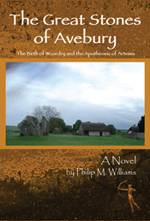
 |
Reviews
Dear Mr. Williams,
Thank you very much for sending me a copy of your book. It is a substantial tome and I applaud you for developing such an interesting approach to prehistory and bringing it to life in this way. We academic archaeologists are constrained by our work/jobs and don't usually feel able to let the imagination run beyond all those maps and plans and statistics. So well done, and again thank you.
With best wishes,
Caroline Malone
Dr Caroline Malone - Reader in Prehistoric Archaeology, Director of Education.
School of Geography, Archaeology and Palaeoecology, Queen's University Belfast, BT7 1NN

Philip Williams opens to us the world of the late Stone Age in England, through the a story of two teenagers, Amy and Jake, and their older mentor, Ralph, as they move huge stones, weighing many tons, painstakingly and skillfully over a hilly landscape to their site in Avebury.
We easily forget that there were personal lives unfolding in those days as well as our own, though there was not yet the written word to record them. In an unusual piece of writing – a novel with what are practically mini-essays on everything from long-distance running to contemporary culture blended seamlessly into it – Williams engagingly depicts three of those lives, along with the hardship, dangers and joys bound up in them. The writing, like the tools of the three, is at times rough-hewn, but that is part of is uniqueness. Its spirit, and indeed what one might take to be the philosophy of the tale itself, is epitomized in the author’s characterization of the village of Avebury, It has, he writes, ”an uneven balance, a symmetry of differences: the round trench, ever changing, the angular stones, ever the same, small people, smaller sheep, motion, stability. It is an artistic tweaking of the earthly world. It proclaims that perfection is not in the perfect, but that the world of man is an expression of the immutable world.(p. 80)
The connection with the earth, and the daily challenges their efforts encounter, define throughout the personal interactions of the three. “Controlling the motion of a large body,” the author writes, “particularly something as dense and as dangerous as a large stone, serves to focus one’s thinking. One is surprised and humbled by the experience.”(164). The surprises are constant, and the humbling considerable, in this extended but temporary intersection of the lives of Amy, Jake, and Ralph. Much of the humbling is experienced by Jake, but the more dramatic adventures are centered around Amy, whose skill at archery and penchant for long distance running, serve her well, whether in dealing with wolves or with marauding bands of thieves.
The world, as they experience it, has an almost Taoist character to it, requiring to be respected and worked with rather than against. As Ralph observes at one point, speaking of the stones they are moving: “They’re not like the stones of Egypt, or the stones at Stonehenge, which are cut at the quarry before they are moved. Here we are dealing with the unique personality of each of our stones.”(193). Like their stones, Amy, Jake and Ralph have unique personalities, and Williams gives us insight into them, as well, perhaps inadvertently, as into his own, in this unusual and charming story.
By Robert Lawrence Holmes
|

